by Ted Beyer
Fidget spinners are the latest fad to sweep, seemingly, the world. Love them or hate them, they are everywhere—on playgrounds, in backyards, living rooms, and even schools, although many schools have banned them as being distractions. But wait just a minute here! For once, let’s see if we can’t use a fad to teach something. You see, there is actually a fair bit of science lurking in those spinney things.
First off (and you may well know this, but bear with me as we get everyone up to speed), there are many different flavors of fidget spinners: ones with two arms, three arms, or more. Metal ones, plastic ones, glow-in-the-dark ones, light-up ones… The variations are seemingly endless, but they all share a few key characteristics. All of them rely on central bearings that makes the spin happen. The quality of these bearings is a major factor in how long and how fast your spinner will spin. All spinners also have some form of weight at the end of their arms—whether it’s a metal insert or just a swelling of the shaped plastic.
Sir Isaac Weighs In on Fidget Spinners
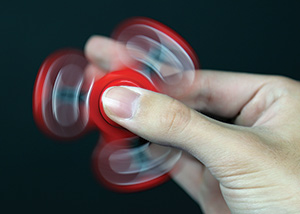 As I am sure you have already figured out, fidget spinners are just full of physics. Predictably enough, Sir Isaac Newton is going to have a lot to say about how these things work. Let’s take a look.
As I am sure you have already figured out, fidget spinners are just full of physics. Predictably enough, Sir Isaac Newton is going to have a lot to say about how these things work. Let’s take a look.
The First Law of Motion generally tells us that an object will remain at rest or in motion unless acted upon by an external force. So our fidget spinners, sitting motionless on a table, will remain motionless unless we spin them. Similarly, if they are spinning, they’ll keep spinning unless acted on by an external force. Well, there are lots of external forces acting on it—just wait for the Third Law, and we’ll talk more!
Now Sir Isaac’s Second Law of Motion is a bit less obvious and a bit more complicated to explain, but no less important to our spinner. Here’s the big formal version:
“The acceleration of an object as produced by a net force is directly proportional to the magnitude of the net force, in the same direction as the net force, and inversely proportional to the mass of the object.”
Huh? Yeah. Me, too.
Let’s say that another way: how fast an object speeds up or slows down depends on how big the object is and how much force you use to make it move or stop moving.
So if we have a big heavy spinner, it’s going to take more force to get it moving, but it is also going to spin longer—everything else being equal. Remember the weights at the end of the arms? They are a direct influence here. Since the weight is at the end of the arms, it causes the spinner to appear to be (from a physics point of view) a solid disk about the same diameter as the arms. (Stick with me—a bit further down, we’ll talk about how we can prove this, but let me get though the last law first, okay?)
Newton’s Third Law of Motion is back to being pretty obvious. For every action there is an equal and opposite reaction. Remember when we were talking about the First Law, I promised to talk more about those external forces? Well, the friction of the bearing is one external force that acts on our spinner. (I told you that was going to be a major thing!)
Air resistance—such as the air you feel rushing by when you wave your hand back and forth—is another external force. Even gravity will have an effect as it pulls downward on the spinner, causing more friction. Together, all of these forces are the reason why your spinner doesn’t keep going forever.
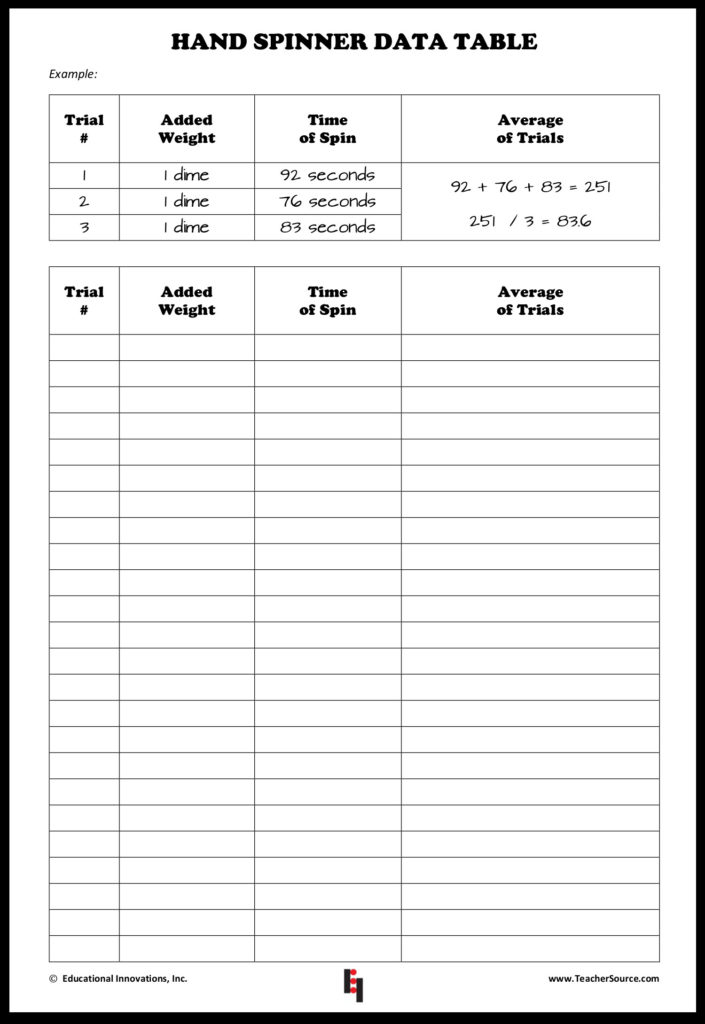 We can boil all that down into some very general statements: the better the bearings, the longer it will spin. The heavier it is, the longer it will spin. The less air resistance, the longer it will spin.
We can boil all that down into some very general statements: the better the bearings, the longer it will spin. The heavier it is, the longer it will spin. The less air resistance, the longer it will spin.
Time to Do Some Experiments!
Let’s look at that proof I mentioned up there in the Second Law. My friends in the graphics department have added a data sheet here for you to help out with this experiment, so take a sec and print that out. Click here or on the image at right.
Got it? Good.
Now put your spinner flat on a table. Put one finger on the center point to hold it steady, and use your other hand to spin it. Once you get it going, you can take that first finger away. Get a friend to help out with a watch or other timepiece, and measure how long it spins. Note that time down on your data sheet. Do this three or four times (or more… More is better—we left you lots of space!).
Once you’ve repeated your test, average those times (add them all up and then divide by the number of times you did it). Next, tape coins to the top of each arm of your spinner. Nickels are good for this, quarters are even better. Be neat with the tape, and use the same kind and number of coins on each arm. Now get back to spinning and timing. Spin the same number of times as you did without the coins attached, and take the average again.
Example:
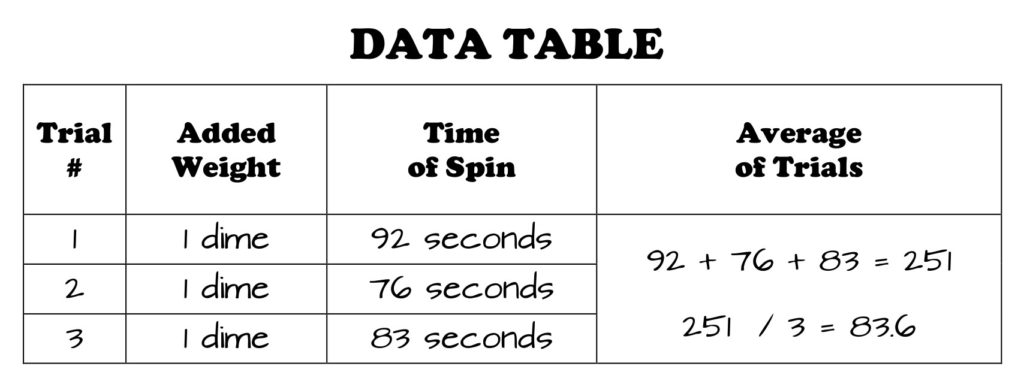
What do you notice? The spins with the additional mass of the coins should be longer than the ones without.
See? Sir Isaac was a really smart guy—told ya!
Just FYI: You can take this even further if you like. Steadily add more coins, and keep re-running the experiment with more and more added mass. Eventually, if you have a LOT of time to kill, you will reach a point where more mass does not increase the spin time. Why? That would be the effect our old enemies, friction and gravity, working together.
One last thing before we leave this experiment. You can use the same process with any two different spinners—no extra weights—just use it to compare which spins longer. As we have seen, that will be a function of both the mass and, of course, the quality of the bearings.
What Else Can We Learn from Fidget Spinners?
We can look at another type of energy the spinners give off as they spin. Get your spinner going really fast and hold it up to your ear, edge side on. You will probably hear the rushing sound that the bearings make, but you are also going to hear a lower humming sound. That’s sound energy caused by the arms of the spinner creating micro changes in air pressure. The frequency of the hum falls as the spinner slows down since the pressure changes are occurring ever more slowly. The energy required to produce that sound is another drain on the energy you put in when you got your spinner moving, and is also acting to slow it down, just like the friction, etc.
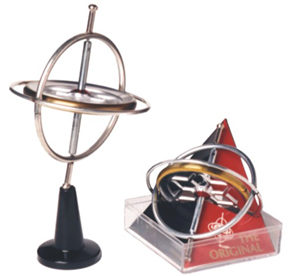 To look at other observable effects of Sir Isaac’s teachings, get the spinner going nice and fast, holding the center tab between your thumb and forefinger. Twist your hand left and right. Or forward and back. Feel that resistance? Please meet our new friend, angular momentum.
To look at other observable effects of Sir Isaac’s teachings, get the spinner going nice and fast, holding the center tab between your thumb and forefinger. Twist your hand left and right. Or forward and back. Feel that resistance? Please meet our new friend, angular momentum.
This relates to the First Law: the object in motion (the spinner) wants to keep going in the same direction, so you need to exert a fair amount of force to get it to change. This is the same principle involved in gyroscopes (our Classic Gyroscope, for example).
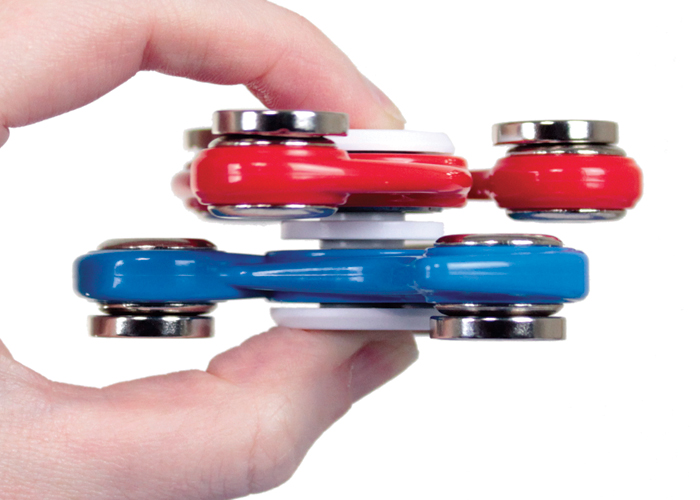 Incidentally, we now have a special set of Double Hand Spinners that makes it possible to hook two or more spinners together at their center. Once the two spinners are connected, you can spin one in a clockwise direction and the other in the opposite (counter clockwise) direction. Doing this “magically” cancels out the angular momentum we just observed. The two equal masses’ motion cancel each other out. Pretty cool! There are any number of other things you can do with the Double Hand Spinners—including some fairly amazing things with magnets. Check out our lesson online.
Incidentally, we now have a special set of Double Hand Spinners that makes it possible to hook two or more spinners together at their center. Once the two spinners are connected, you can spin one in a clockwise direction and the other in the opposite (counter clockwise) direction. Doing this “magically” cancels out the angular momentum we just observed. The two equal masses’ motion cancel each other out. Pretty cool! There are any number of other things you can do with the Double Hand Spinners—including some fairly amazing things with magnets. Check out our lesson online.
Speaking of getting your spinner going really fast, here’s another idea that involves a can of compressed air with the “straw” concentrator on it. First, start the spinner moving. Then aim the straw at the edge of the outer arm and blast it with the compressed air. You will see, hear, and feel the spinner rapidly accelerate! All of the effects we have talked about above will be magnified since we have pumped so much more energy into the spinner.
A couple of last things before the boss makes me go back to “real” work. Apparently I have been having too much fun playing with spinners as I write this.
As I mentioned above, our Double Hand Spinners (which come with six magnets) are incredibly cool. I could easily write another entire blog on them alone, but there are things you can do with some magnets and any spinner—not just our doubles. Put magnets on the ends of all the arms of two different spinners. Put them next to each other, and start them both spinning—gently. You will have to experiment with the power of the magnets and the distance between the spinners, but you might be surprised by the results. We have found that our Neodymium Magnets work really well for experiments like this.
Then there’s the Wagon Wheel Effect. If you look at a spoked, spinning object (like, well, a wagon wheel or an airplane propeller or such), it will appear to reverse direction or even stop when observed under certain conditions. The easiest way to observe this with a Hand Spinner is to take a video and watch the playback. I suggest you to look up the why and how your eye (and the camera) sees what it sees. I would have to write yet another entire blog to explain it here!
Finally, I’ll leave you with this thought: fidget spinners might seem to be a scourge, a distraction, and an irritant in the classroom, but this is a PERFECT moment to grab your students’ interest and turn what might at first seem to be a pain into a really teachable moment. Don’t worry—Sir Isaac will be right with you as you do.
UPDATE: Fidget spinners in space?!
From NASA’s Johnson Space Center – a great way to experiment with Newton’s laws of motion!
